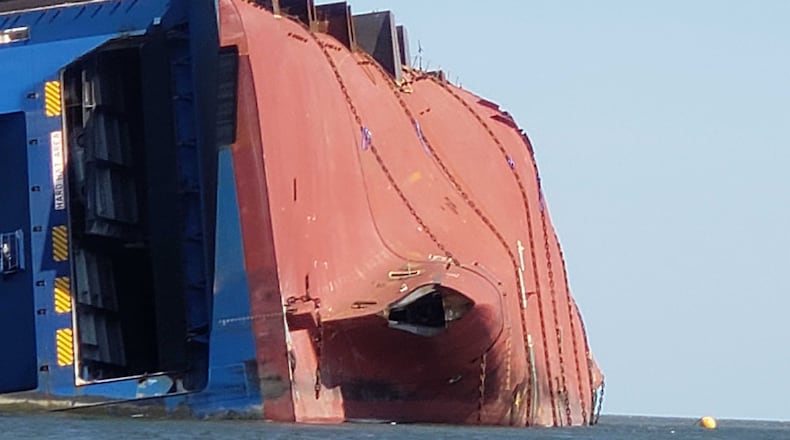Instability from a cargo load that left the ship’s center of gravity too high likely caused the Golden Ray to capsize just over a year ago in the St. Simons Sound, according to modeling conducted by the U.S. Coast Guard.
Lt. Ian Oviatt, staff engineer at the Coast Guard Marine Safety Center in Washington, D.C., revealed on Tuesday that the ship could have avoided capsizing by adding water to the ballast tanks, compartments designed to hold water and provide vessel stability, before leaving the Port of Brunswick.
The 656-foot ship and its cargo of more than 4,000 cars has remained in the St. Simons Sound since Sept. 8, 2019, when it rolled over on its port side. Salvage operations to remove the ship by cutting it into large sections have been delayed until early October.
During a seven-day virtual public hearing that ended Tuesday, part of the ongoing investigation led by the U.S. Coast Guard, witnesses including the ship’s captain and the local pilot who was steering the ship at the time of the incident described what happened in the hours before the ship capsized. The U.S. Coast Guard and the National Transportation Safety Board will issue final reports with recommendations to prevent similar incidents.
The Golden Ray, built in 2017 and owned and operated by Hyundai Glovis, had already been delayed four days to avoid possible impacts of Hurricane Dorian. With the storm approaching, the ship added water to the ballast tanks to improve stability but released it prior to arriving at the Port of Brunswick, said witnesses.
All witnesses agreed that operations were normal as the ship sailed into Brunswick. At the port, stevedores unloaded about 280 Kia Forte and Accent cars from two decks of the car carrier before loading and securing more than 300 Georgia-made Kia Telluride trucks. Overflow that did not fit on the two decks where cars were removed were added to an additional deck, said witnesses.
In a statement, the ship’s chief officer, Hyunjin Park, said the ship had begun to list port side during cargo loading at Brunswick but was stable prior to departure. The ship pulled out of port on schedule, but just a half-hour later, events would take a sudden turn.
The Golden Ray — a large car carrier with the capacity to hold more than 7,000 vehicles — required a maritime pilot to enter and exit the Port of Brunswick. Jonathan Tennant, the pilot on duty, and the ship’s captain, Gi Hak Lee, agreed the outbound passage was normal until Tennant executed a 20-degree right rudder command to starboard.
Credit: Georgia Department of Natural Resources, U.S. Coast Guard
Credit: Georgia Department of Natural Resources, U.S. Coast Guard
Tennant said he ended up over rotated but attempts to compensate didn’t improve the situation. “... it felt like someone pulled the rug out from under me and we went over,” he said.
Lee, who had just taken command of the Golden Ray in August 2019, said he did not object to any of Tennant’s commands. “When the pilot gave the command starboard 20 and the ship started listing, that is when I first realized there was a problem,” Lee said.
At that point, the vessel likely lacked the ability to right itself, said Oviatt, noting that the ship was not in compliance with established stability codes for large vessels.
“The cause of the vessel capsizing was the lack of righting energy due to the way in which the vessel was loaded," Oviatt said. “The vessel could have taken on additional ballast to be in compliance with the 2008 Intact Stability Code. The cargo could have also been shifted so that cargo was at a lower center of gravity.”
In addition, Oviatt indicated that the pilot door on the port side of the ship, which had been opened for Tennant’s departure as the ship crossed under the Sidney Lanier Bridge, only exacerbated the capsizing of the Golden Ray by allowing water to enter the vessel as the ship began tilting to the side.
Though previous reports suggested a fire had broken out before the ship capsized, none of the witnesses testified to seeing smoke or flames before the ship rolled over and came to rest on the sandbar.
Jeffrey Falzarano, an expert in hydrodynamic stability from Texas A&M University, compared the incident to the plight of the Hoegh Osaka, a car carrier that ran aground in the United Kingdom in 2015.
That ship’s stability did not meet the minimum international requirements for ships proceeding to sea, according to the final investigation reported by the BBC, which also noted that it had become practice in the car carrier sector to not calculate actual stability conditions after completing cargo operations but before the ship sails out to sea.
About the Author
Keep Reading
The Latest
Featured




